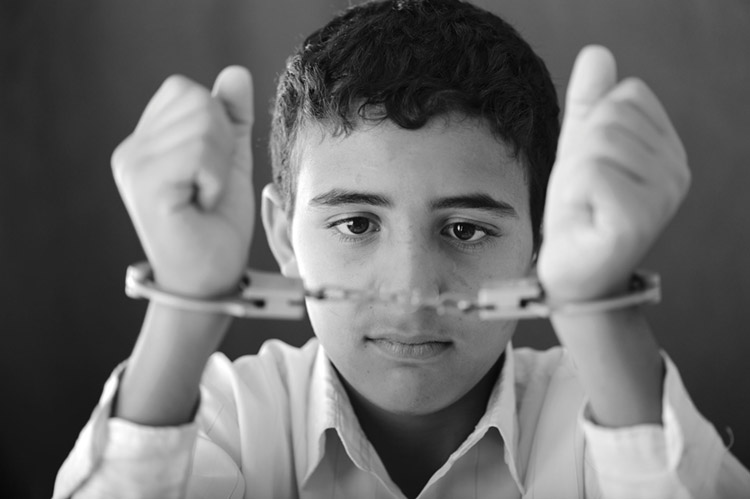ABA will advocate to end unreasonable restraints, seclusion and searches of children

Shutterstock
Leslie Margolis once represented a 7-year-old child in foster care who had been restrained more than 147 times by his school’s staff.
She saw a video recording of the child being dragged down a hallway by his arms and placed in a seclusion room, where he was found 10 minutes later sitting in a pool of blood with an injury to his nose.
“That was his 57th seclusion since the school year had begun 2½ months before,” said Margolis, managing attorney of Disability Rights Maryland. “Twenty of those incidents lasted more than 30 minutes, and several lasted more than an hour.”
Margolis shared the story with the House of Delegates at the ABA Annual Meeting as it considered a trio of resolutions related to the well-being and rights of children and youth.
She spoke in favor of Resolution 103, which urges governmental bodies to adopt and enforce legislation and educational policies that prohibit school personnel from using seclusion and mechanical or chemical restraints on students in preschool through 12th grade.
The resolution, sponsored by the Commission on Disability Rights and Section of Civil Rights and Social Justice, also urges jurisdictions to bar personnel from physically restraining students unless they pose a danger to themselves or others. If personnel must use physical restraint because other less intrusive interventions are deemed inappropriate or fail, it says they should not place students face down or in any position that hinders their ability to breathe or communicate distress.
Margolis said that in schools nationwide, children face serious physical injuries, psychological trauma and even death after they have been restrained or placed in seclusion. She added that children with disabilities and children of color are disproportionately affected by these interventions.
Data from the U.S. Department of Education’s Office for Civil Rights shows that 124,500 students were physically or mechanically restrained or secluded in the 2015-2016 school year, according to the report that accompanied the resolution.
While students with disabilities comprise 12% of total enrollment, they comprise 71% of students who were restrained and 66% of students who were secluded, according to the data.
African American students are 15% of total enrollment but represent 27% of those restrained and 23% of those secluded.
Robert Dinerstein, director of the Disability Rights Law Clinic at American University Washington College of Law, also told the House that seclusion and restraint are “not therapeutic,” and they are instead “used as a means of control and convenience.”
While some courts have addressed the use of seclusion and restraint in schools, he said Congress has tried but failed to pass federal legislation.
“Regulation of seclusion and restraint is left to the states, where there is wide variation in law and practice, and where many states report no use of seclusion and restraint when, in fact,we know there is quite a bit of it,” said Dinerstein, a member of the Commission on Disability Rights.
The resolution, which passed overwhelmingly, asks that jurisdictions require school personnel to complete training in positive behavior interventions and trauma-informed care, including crisis de-escalation and restorative practices.
Restricting strip searches
The second measure, Resolution 111B, urges governmental bodies to adopt policies and contractual provisions that prohibit strip searches of children and youths, except in exceptional circumstances.
The resolution, put forward by the Section of Litigation and supported by several ABA entities, says these circumstances include when children and youths are in custody; when they are reasonably suspected to possess or have had immediate access to an implement that could endanger themselves or others; when they have been presented with all other less-intrusive methods to find and remove the implement; or when they have been told they will be searched and can reveal the implement before the search.
It also asks that necessary strip searches be conducted by means that are least intrusive and respectful of a child or youth’s sexual orientation and gender identity, and that body cavity searches be completely prohibited.
Eileen Letts, a delegate of the Section of Litigation, told the House when moving the resolution that research shows strip searches are “demeaning, dehumanizing, undignified, humiliating, terrifying, unpleasant, embarrassing and repulsive, and signify degradation and submission.”
Even though research also shows strip searches could have a “lifelong impact on an adolescent’s developing mind,” she said they have become increasingly common in juvenile detention centers, immigration detention centers, during child welfare investigations and prior to visits with incarcerated family members.
While some states provide guidance on strip searches of children and youths, the report accompanying the resolution says individual agencies and facilities generally create their own policies and contractual provisions.
It cites several examples, including youths in a juvenile detention center in Georgia who are strip searched when they first enter the facility; after they are taken to medical appointments or court appearances; and after any visit by family, friends or lawyers.
Resolution 111B, which passed overwhelmingly, encourages the legal community, law enforcement and medical professionals to promote awareness of the harmful effects of strip searches and body cavity searches on children and youths.
Lourdes Rosado, a member of the Section of Litigation’s Children’s Rights Litigation Committee working group and a lead drafter of the resolution, says now that it’s been adopted, the next step is to help attorneys educate the public.
“We are going to be working on a toolkit that we can send out to practitioners so they can advocate on behalf of children to their state legislatures, state agencies that contract with these facilities, school boards and all of the actors who have children in custody in one form or another as part of their work,” she says.
Lived experience
The third resolution that focuses on the experience of children and youths was also overwhelmingly passed at the annual meeting.
Resolution 115, submitted by the Commission on Youth at Risk and the Section of Civil Rights and Social Justice, recognizes that child welfare, immigration and juvenile justice systems as well as other legal systems that affect the fundamental rights of children and youths cannot be reformed without the active participation of individuals who experienced those systems.
Speaking in favor of the resolution, Lily Colby, a member of the commission, told the House she grew up in the foster care system.
“I have shared bunk beds and bathrooms and holiday meals with people of different races, religions, classes, abilities and disabilities, sexual and relationship orientations, gender identities and expressions,” she said.
“As I grew up, I learned what little power I had over the circumstances in my life,” she added. “As a ward of the court, my daily life was drastically affected by the law.”
Despite the odds, Colby graduated from college, went on to law school and interned at the ABA Center on Children and the Law. She now helps other families that have been impacted by the foster care system.
“Along the way, I met youth and adults with lived experience in our systems who have inspired me,” she said. “Sharing the ways in which policies impact families, they have changed laws, they have changed regulations, and they have changed cultures.”
Dafna Gozani, an attorney with the National Center for Youth Law’s California Youth Justice Initiative, told the House she is one of several people on her team who have been directly impacted by the juvenile justice system.
She said the commission solicited input from other individuals with lived experience in legal systems as well as from organizations with effective youth engagement programs. In providing their perspectives, the resolution also highlights the barriers faced by many as they attempt to work in the legal and policy fields.
“As the result of the discrimination and biases that plague our legal system, Black, Latino and Indigenous youth are disproportionately represented in child welfare, immigration and juvenile justice legal systems,” she said.
“These are the very same populations that are vastly underrepresented in the legal profession.”
Resolution 115 also urges law schools, law firms and other legal organizations to help people with these backgrounds pursue legal and advocacy careers, and it calls on organizations that focus on youth legal-system reform to recruit them as staff members, board members and other leaders.
The resolution was co-sponsored by the Commission on Immigration.



